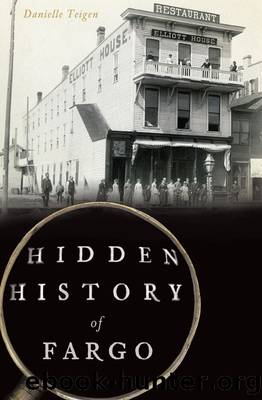Hidden History of Fargo by Danielle Teigen

Author:Danielle Teigen [Teigen, Danielle]
Language: eng
Format: epub
Tags: Photography, Subjects & Themes, Regional, Travel, United States, Midwest, West North Central (IA; KS; MN; MO; ND; NE; SD), History, State & Local, Midwest (IA; IL; IN; KS; MI; MN; MO; ND; NE; OH; SD; WI)
ISBN: 9781439662090
Google: Oy8vDwAAQBAJ
Publisher: Arcadia Publishing
Published: 2017-08-28T15:58:03+00:00
BECOMING A BUSINESSWOMAN
Soon after, Matilda ventured into dressmaking, opening a shop that proved so successful she hired a âcutter and fitter from New York and two seamstresses.â215 She began by sewing clothes for her own family and then branched out to more people, like her husbandâs cousin, Samuel, who wore her finely tailored clothes for ten years. Thanks to Matildaâs business, the small city of three thousand offered women modern clothes seen in Paris and New York City. The wives of pioneer settlers wanted finery, and Matilda met their demand. âThe shop was successful from the moment it started. There was no ready-to-wear industry in those days. The wives of the settlers had endured poverty and privation for several years. As soon as their husbands made a little money their thoughts turned to clothes.â216
Matilda added millinery to her dressmaking shop, importing materials and trim from New York. She quickly outgrew her small space, rented the store to a jeweler and set up in a new, larger store. Matildaâs store boomed, so much so that in 1877 when her husband returned from the Black Hills, he let her keep the shop open. Good thing, too, because heâd returned with very little fortune, save for a couple of ponies his sons kept as pets.
So Matilda ran her shop, and Charles ran his flour mill and brickyard and farmed land. He invested heavily in various properties in Fargo, and Matilda âadvised her husbandâs cousin, S.G. Roberts, to buy the lots that he did and they became downtown Fargo.â217 They had hired a Swedish nanny to watch their three boys.
During down years in farming, Matildaâs shop helped tide the family over when income was reduced. (Charles tried to provide for his family but got involved in a few risky business ventures. His mill burned down twice, though he rebuilt it. He also invested in Fargoâs failed streetcar system, as well as the Sanborn, Cooperstown and Turtle Mountain Railroad.) Matilda eventually sold her dressmaking shop but took to selling sewing machines instead.
During the winter of 1881, Matilda took her three small sons to California to escape the Dakota winter. Charles joined them for a time, and soon trips to the West Coast became regular for the Roberts family.218
Download
This site does not store any files on its server. We only index and link to content provided by other sites. Please contact the content providers to delete copyright contents if any and email us, we'll remove relevant links or contents immediately.
Shoot Sexy by Ryan Armbrust(17685)
Portrait Mastery in Black & White: Learn the Signature Style of a Legendary Photographer by Tim Kelly(16973)
Adobe Camera Raw For Digital Photographers Only by Rob Sheppard(16929)
Photographically Speaking: A Deeper Look at Creating Stronger Images (Eva Spring's Library) by David duChemin(16650)
Bombshells: Glamour Girls of a Lifetime by Sullivan Steve(14019)
Art Nude Photography Explained: How to Photograph and Understand Great Art Nude Images by Simon Walden(12998)
Perfect Rhythm by Jae(5354)
Pillow Thoughts by Courtney Peppernell(4241)
The Book of Joy by Dalai Lama(3941)
Good by S. Walden(3516)
The Pixar Touch by David A. Price(3389)
A Dictionary of Sociology by Unknown(3044)
Fantastic Beasts: The Crimes of Grindelwald by J. K. Rowling(3028)
Humans of New York by Brandon Stanton(2847)
Stacked Decks by The Rotenberg Collection(2841)
Read This If You Want to Take Great Photographs by Carroll Henry(2682)
On Photography by Susan Sontag(2605)
Insomniac City by Bill Hayes(2519)
Photographic Guide to the Birds of Indonesia by Strange Morten;(2507)
